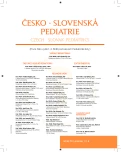Influence of heel valgus on foot motion during walking in children aged 3–8 years
Authors:
L. Honzíková 1,2; E. Kuboňová 1; Z. Svoboda 1; M. Janura 1; J. Rosický 2
Authors‘ workplace:
Katedra přirodnich věd v kinantropologii, Fakulta tělesne kultury, Univerzita Palackého, Olomouc
vedouci katedry prof. RNDr. M. Janura, Dr.
1; Ortopedická protetika, Frýdek-Místek
manažer výzkumu a vývoje ing. J. Rosický, CSc.
2
Published in:
Čes-slov Pediat 2015; 70 (6): 323-328.
Category:
Original Papers
Overview
The optimal function of the foot is very important for postural stability and locomotion. One of causes of functional abnormalities in certain areas of the foot may also be heel valgus deformity. The aim of this study was to assess influence of heel valgus on the range of motion of selected foot segments during gait in children aged from 3–8 years. The participants were divided into three groups: unilateral heel valgus (n=12, age 5.8±1.6 years), bilateral heel valgus (n=8, age 5.4±1.4 years) and control (n=7, age 4.9±1.5 years). Heel valgus angle was defined as a deviation of heel axis from the vertical line. Five trials for each child were analysed using optoelectronic system Vicon MX (six infrared cameras, frequency 200 Hz). The results of our study showed that heel valgus significantly decreases hindfoot range of motion in the frontal plane and each observed group had different compensation mechanism.
Key words:
hindfoot movement, forefoot movement, kinematic analysis, biomechanics
Sources
1. Michaud TC. Foot Orthoses and Other Forms of Conservative Foot Care. Newton, MA: Thomas C. Michaud, 1997: 1–250.
2. Valmassy RL. Clinical Biomechanics of the Lower Extremities. St. Louis, MO: Mosby Inc., 1996: 1–528.
3. Wernick J, Volpe RG. Lower extremity function and normal mechanics. In: Valmassy RL. Clinical Biomechanics of the Lower Extremities. St. Louis, MO: Mosby Inc., 1996: 1–58.
4. Chen KC, Yeh CJ, Tung LC, et al. Relevant factors influencing flatfoot in preschool-aged children. Eur J Pediatr 2011; 170 (7): 931–936.
5. Harris JE, Vanore JV, Thomas JL, et al. Diagnosis and treatment of pediatric flatfoot. J Foot Ankle Surg 2004; 43 (6): 341–373.
6. Pfeiffer M, Kotz R, Ledl T, et al. Prevalence of flat foot in preschool-aged children. Pediatrics 2006; 118 (2): 634–639.
7. Dungl P, a kol. Ortopedie. Praha: Grada, 2005: 1–1280.
8. Mooney J, Campbell R. General foot disorders. In: Lomier D, et al. Neale’s Disorders of the Foot. Elsevier Edinburgh, 2006: 89–164.
9. Adamec O. Plochá noha v dětském věku: Diagnostika a terapie. Pediatr praxi 2005; 5 (4): 194–196.
10. Pastucha D, Hyjánek J, Malinčíková J. Incidence dyslipidemií v populaci dětí s obezitou. Čes-slov Pediat 2012; 67 (3): 147–151.
11. Kollárová R, Gerová Z, Potičný V, Šebeková K. Prevalencia nadhmotnosti a obezity u študentov bratislavských stredných škôl – predbežné výsledky štúdie „Rešpekt pre zdravie“. Čes-slov Pediat 2013; 68 (4): 211–218.
12. Lin CJ, Lai, KA, Kuan TS, Chou YL. Correlating factors and clinical significance of flexible flatfoot in preschool children. J Pediatr Orthoped 2001; 21 (3): 378–382.
13. Leardini A, Sawacha Z, Paolini G, et al. A new anatomically based protocol for gait analysis in children. Gait Posture 2007; 26 (4): 560–571.
14. Lee JH, Sung IY, Yoo JY. Clinical or radiologic measurements and 3-D gait analysis in children with pes planus. Pediatr Int 2009; 51 (2): 201–205.
15. Hösl A, Böhm H, Multerer Ch, Döderlein L. Does excessive flatfoot deformity affect function? A comparison between symptomatic and asymptomatic flatfeet using the Oxford foot model. Gait Posture 2014; 39 (1): 23–28.
16. Leardini A, Benedetti MG, Berti L, et al. Rear-foot, mid-foot and fore-foot motion during the stance phase of gait. Gait Posture 2007; 25 (3): 453–462.
17. Twomey D, McIntosh AS, Simon J, et al. Kinematic differences between normal and low arched feet in children using the Heidelberg foot measurement method. Gait Posture 2010; 32 (1): 1–5.
18. Ness M, Long J, Marks R, Harris G. Foot and ankle kinematics in patients with posterior tibial tendon dysfunction. Gait Posture 2008; 27 (2): 331–339.
19. Simon J, Doederlein L, McIntosh AS, et al. The Heidelberg foot measurement method: development, description and assessment. Gait Posture 2006; 23 (4): 411–424.
20. Wolf S, Simon J, Patikas D, et al. Foot motion in children shoes – A comparison of barefoot walking with shod walking in conventional and flexible shoes. Gait Posture 2008; 27 (1): 51–59.
21. Khamis S, Yizhar Z. Effect of feet hyperpronation on pelvic alignment in a standing position. Gait Posture 2007; 25 (1): 127–134.
22. Tiberio D. The effect of excessive subtalar joint pronation on patellofemoral mechanics: a theoretical model. J Orthop Sports Phys Ther 1987; 9 (4): 160–165.
23. Dylevský I. Speciální kineziologie. Praha: Grada, 2009: 1–184.
24. Perry J. Gait analysis: Normal and pathological function. Thorofare, NJ: USA: SLACK Incorporated, 1992: 1–524.
25. Hunt A, Smith RM. Mechanics and control of the flat versus normal foot during the stance phase of walking. Clin Biomech 2004; 19 (4): 391–397.
Labels
Neonatology Paediatrics General practitioner for children and adolescentsArticle was published in
Czech-Slovak Pediatrics

2015 Issue 6
Most read in this issue
- Primary (autoimmune) sclerosing cholangitis in patient with inflammatory bowel disease
- Nicotine alters brain development
- Influence of heel valgus on foot motion during walking in children aged 3–8 years
- Aspergillus fumigatus and cystic fibrosis lung disease – the overview
